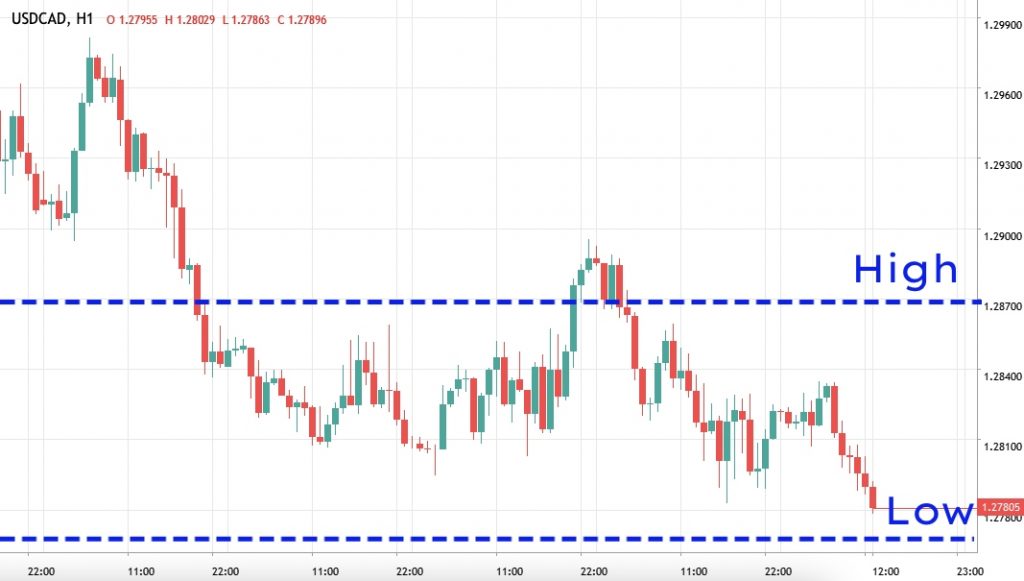Boundary Options Trading


Boundary options trading involves determining whether the price of an asset will finish within a specified range. This popular form of binary option is also known as an In/Out contract. In this trading tutorial, we explain how boundary options work with examples, plus their respective benefits and drawbacks. We also list the best boundary options trading brokers in 2026.
Boundary Options Brokers
Boundary Options Explained
Boundary options follow a straightforward ‘yes or no’ logic and have a fixed expiry time, much like standard binary options. However, instead of speculating whether the price of an asset will be higher or lower than the current price at expiry, upper and lower figures are set, and the trader predicts whether the price will finish within or outside of the range, also known as a boundary.
If the price is within the high and low range at expiry, the contract finishes ‘in the money’ and the trader takes home the payout. If the price finishes below or above the bracket then the contract finishes ‘out of the money’ and the investor loses their initial deposit. On some platforms, traders can also speculate that the price will finish outside of the range to receive the payout.

Note, boundary options are also known as range, tunnel, in/out, and double barrier options.
Example 1
Let’s see how a boundary options trade works in practice…
Amazon stock is currently trading at $2,295.45 per share. But with no company announcements planned and following technical and fundamental analysis, a trader believes the price will remain relatively stable. Therefore, the investor purchases 10 boundary options contracts with a low barrier of $2,290.00 and a high boundary of $2,300.00. The contract will expire at 15:00 the next day. Each boundary option has a $20 premium and pays out $40 if the trade finishes ‘in the money’.
The price is $2,297.75 at 15:00 the following day, which is within the agreed range. As a result, the trader receives a payout of $400 (10 * $40), including $200 in profit ($400 – $20 premium per contract).
If the share price had finished outside of the barriers at the time of expiry, the trader would have lost $200 (10 * $20 premium).
Example 2
Let’s also look at an example where a trader believes the price will finish outside of the agreed range…
The investor is speculating on a highly volatile cryptocurrency that is currently trading at $700.00. The trader thinks the price will fluctuate significantly within the next 24 hours so buys 10 boundary options at $20 per contract with a lower level of $675.00 and a higher level of $725.00. However, unlike the example above, the trader will receive a payout if the price does not finish within the agreed range. The payout per contract is $40.
The following day, the value of the coin continues to swing wildly and is worth $650.00 at the point of expiry. Because the trader believed the price would land outside of the boundary, they receive a $400 payout (10 * $40).
If the price of the coin had been within the range, for example, $710, the trader would have lost $200 (10 * $20 premium).
Using Boundary Options To Hedge
Boundary options can also be used to hedge against positions and products in other markets. For example, if a trader has gone long on a particular stock, they could enter a boundary option within the barriers to protect themselves if the price of the asset does not increase. Let’s look at this in more detail…
Say an investor buys $100 worth of a new coin ‘$tacked’, which is currently trading at $1.00. New digital currencies are notoriously volatile and the investor is aware that a major announcement about the benefits of the latest blockchain technology is scheduled for tomorrow, which could lead to an increase in the value of $tacked.
But while this might be the investor’s theory, in case the market doesn’t react and the price remains flat; the trader buys a boundary option with ranges above and below the current price. Any gains that don’t materialize because the price remains stable could be offset by the profits from the boundary option position. Equally, any losses if the price finishes outside of the barriers could be offset by the profit earned if the value of the coin increases.
Pros Of Boundary Options Trading
There are several advantages to trading boundary options:
- Small capital requirement – Traders only need to pay the premium per option while spot trading stocks, for example, can require a much larger capital outlay
- Low maintenance – Unlike other asset classes, binary options have a simple yes/no outcome so there is less need for traders to constantly monitor charts and positions
- Price – The cost of trading is limited to the number of options bought multiplied by the premium per option. This is much lower than other forms of investing, for example, trading on margin
- Timeframes – Boundary options brokers may offer various timeframes, from short-term intraday options to longer-term contracts. This makes binary options popular with a range of traders and strategies
- Easy to understand – Boundary options are suitable for beginners because they are straightforward. A high and low figure is set and the trader simply has to speculate whether the price will finish within or outside the range by the expiry
Cons Of Boundary Options Trading
There are also some drawbacks:
- Access – Not all online brokers offer boundary options trading. See our list of supporting brokers to find the best platforms
- Fixed profits – All gains are predetermined by the broker. The outcome of the trade is either yes or no, and as such, there are no incremental gains outside of the contract
- Market unpredictability – Boundary options are most effective when an asset is trending towards or away from volatility, however, markets can behave unexpectedly leading trades to finish ‘out of the money’

How To Trade Boundary Options
You can get started trading boundary options in a few simple steps:
- Find a broker – Not all binary options brokers offer boundary options. With that in mind, make sure you sign up with a provider that supports the product. Also check the brokerage offers a user-friendly platform, easy-access payment options, competitive payouts, plus a range of underlying assets.
- Research – Use your broker’s charting services to find a suitable trading opportunity. The top platforms also offer fundamental tools, from integrated news feeds to company metrics and market sentiment indicators. Importantly, boundary options are most effective when the price of an asset is either stabilizing or heading towards increased volatility.
- Fund your account – Once you have signed up with a broker and identified a trading opportunity, you will need to deposit funds into your account. You will then need to pay a premium (cost) per option.
- Enter the market – Now it is time to execute your strategy. If the price of the asset looks like it is decreasing in volatility, i.e. the range between the price highs and lows is getting smaller, then traders should enter a boundary option within the confines of the two brackets. If the range between the price highs and lows is increasing then a boundary option outside of the barriers may be a better move.
Final Word On Trading Boundary Options
Boundary options are a popular form of binary options. They offer minimum maintenance, low financial commitment, plus risk and reward are known upfront. They can also be used as part of hedging strategies. Use our guide above to start trading boundary options today.
FAQs
What Are Boundary Options?
Boundary options, also known as In/Out options, have a ‘high’ and ‘low’ figure. Traders then speculate whether the price of the underlying asset will be within or outside of the agreed range when the contract expires, for example, after one day.
What Is The Difference Between Boundary Options And Binary Options?
Boundary options are essentially a form of binary options. A classic binary options contract involves predicting whether the value of an asset, such as gold, will be higher or lower than the current price when the contract expires. With a boundary option contract, a ‘high’ and ‘low’ figure is set and investors speculate whether the price will finish inside or outside of the range at expiry.
Are Profits On Boundary Options Fixed?
Yes – boundary options profits are fixed and agreed upon before you buy a contract. The cost of the contract, known as the ‘premium’, is also known in advance. This price certainty is what makes option contracts popular with many beginners.
Are Boundary Options Risky?
As with all forms of trading, boundary options carry an element of risk. With that said, they do offer the benefit of potential losses being known upfront. This is unlike leveraged CFD trading, for example, where losses can climb if the market moves against you and no risk management tools are in place.
Where Can I Trade Boundary Options?
Not all brokers offer boundary options trading. See our list of supporting brands to find the right provider for your needs.



